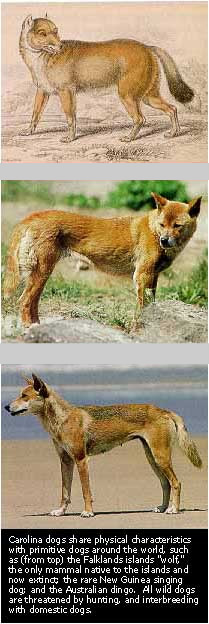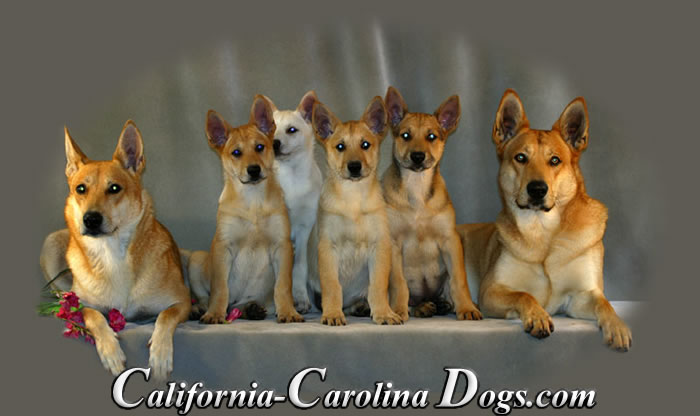“Tracking America's Native Breed”
Copyright 1999 Smithsonian Magazine
All photos by Lynda Richardson
ARTICLE PAGE 1 2 3 4 5
 The
Carolinas are part of what Brisbin calls "the great arc of the
red dog," the worldwide distribution of pariah canids. From
their probable point of evolution somewhere in Southwest Asia
or the Middle East, the ancestors of todays domestic dogs spread
out in tandem with humans into Africa; and southeast through
Java, Australia, New Guinea and then island-hopping through
the South Pacific in rafis and canoes; north through Korea,
Japan, Siberia and then into North and South America
The
Carolinas are part of what Brisbin calls "the great arc of the
red dog," the worldwide distribution of pariah canids. From
their probable point of evolution somewhere in Southwest Asia
or the Middle East, the ancestors of todays domestic dogs spread
out in tandem with humans into Africa; and southeast through
Java, Australia, New Guinea and then island-hopping through
the South Pacific in rafis and canoes; north through Korea,
Japan, Siberia and then into North and South America
In remote corners of the world, away from the later waves of European dogs that hybridized local varieties out of existence, some of the original dogs still survive. Unlike the Carolinas, their ancient lineage is undisputed. The most intriguing, and perhaps the most primitive, is the New Guinea singingdog. Low-slung and muscular, weighing about 25 pounds, with short legs, a long torso and a wide face, it is a curiously feline dog with an ability to climb and jump that is unmatched by any other breed-a handy trait in the sodden, jumbled forests of the New Guinea mountains, where it can scramble up trees like a cat. The name comes from its weird, harmonic howls, whose unearthly qualities prompted one of the highland tribes to claim the Creator had replaced the dog's tongue with the quill of a cassowary, a native bird. These dogs are truly wild animals and rarely seen.
Although singing dogs have been in New Guinea for at least 4,000 years, living examples were only discovered by the outside world in the 1950s. At that time, they were classified as a separate species of wild canict, although today they are officially grouped with the domestic dog.
"It's all part of the package. Morphology and behavior go hand in hand," Brisbin says, gesturing to the lean shape of a nearby dog snuffling through the underbrush. That sinuous, blue-heron neck doesn't seem relevant without the pointed muzzle for stabbing at prey, and the upright ears for sharp hearing, and the long tail with its pale underside for signaling to the rest of the pack. Whether the Carolina dog is an ancient holdover or a modern throwback, its shape and behavior make a lot of evolutionary sense.
Unfortunately, purebred singers have all but vanished from New Guinea as European dogs have moved into the highlands. Today only about a hundred exist in captivity, the descendants of a handful of vald-caught animals, and most of those have been goneutered or are too old to breed. Brisbin has a couple of pairs andhas been working closely with Janice KolerMatznick of Central Point, Oregon, an expert on singers who has founded the Primitive and Aboriginal Dog Society to promote the conservation of ancient canids
While bones tell part of the story, they say little about a dog's outward appearance. Fortunately, in the case of early dogs in the Americas, pre-Columbian art, the accounts of early explorers and works of frontier artists fill in some of the blanks. The average Indian dog apparently looked like a dingo-with a fairly short coat, upcurved tail and upright ears. Judging from 19th-century paintings, the Iroquois raised dogs that would look at home in Brisbin's pack of Carolinas.
Along the Northwest coast around Vancouver Island and the Olympic Peninsula, the Makah and Coast Salish tribes kept two breeds, both now extinct-a typical, dingo-like village dog, and a smaller, longhaired variety with a tightly curled tail raised exclusively for its fur, which was woven into blankets. Dogs in the Arctic, sub-arctic and Great Plains, on the other hand, resembled wolves, with large frames, heavy coats and shaggy tails.
NEXT PAGE